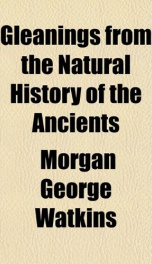gleanings from the natural history of the ancients

Purchase of this book includes free trial access to www.million-books.com where you can read more than a million books for free. This is an OCR edition with typos. Excerpt from book: CHAPTER III. ANTIQUARIAN NOTES ON THE BRITISH DOG. I HERE are few more vexed queftions in the archaeology of natural hiftory than the origin of the dog. The fearcher of bone caverns cannot light upon any definite evidence, inafmuch as the fkulls of dogs, wolves, and their congeners are much the fame. The dog family (cants') makes its firft appearance in the lower Pleiftocene era, along with wolves, elephants, and oxen. There is no trace of dogs or other domeftic animals having been known to or ufed by the cave-men ; but in the Neolithic age the dog was occafionally employed for food, probably when old and paft his work, a more humane, if lefs heroic, ending to a life of hunting than was that of the worn-out Argus when he once more faw his mafter ("Odyfley," xvii. 326). In a Neolithic barrow, however, at Eyford, Mr. Greenwell found a dog which had been undoubtedly buried along with a woman whofe fkeleton was ftill, like that of the dog, insitu. Its jaw fhov/ed it to have been about the fize of an ordinary fhepherd dog. The dog was abundantly reprefented in the Norfolk flint mines known as Grime's Graves.1 The dog is met as the trufted friend of man when hiftorical times commence ; thus its com- monnefs precludes much exact mention of it. Its exiftence was taken for granted. Theory, therefore, flourifhes abundantly in connecTion with the early hiftory of the dog, and much a pofteriori argument. Such guefles muft be taken obvioufly at their own value. Thus it does not follow that man in his primitive exiftence as a hunter was aided by the fkill and fpeed of dogs, although Pope may find it convenient to fuggeft the notion to our minds by his well-known lines on the " poor Indian " and his dog. Many favage tribes which live by hunting, at the prefent day, never employ dog...
Info about the book
Author:
Series:
Unknown
ASIN:
B008PLXQOS
Rating:
3/5 (3)Your rating:
0/5
Languge:
English
Users who have this book
Users who want this book
What readers are saying
What do you think? Write your own comment on this book!
write a commentif you like gleanings from the natural history of the ancients try:
Other books by this author
Do you want to exchange books? It’s EASY!
Get registered and find other users who want to give their favourite books to good hands!



